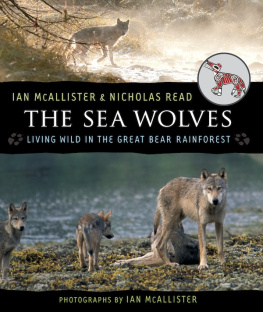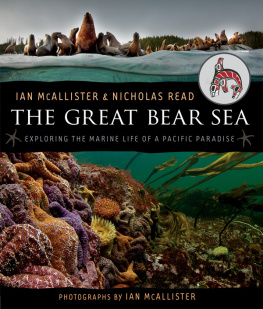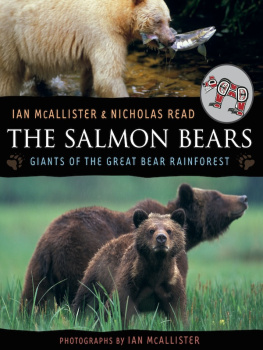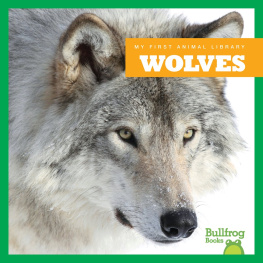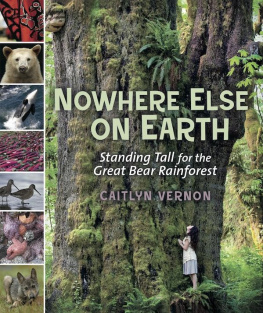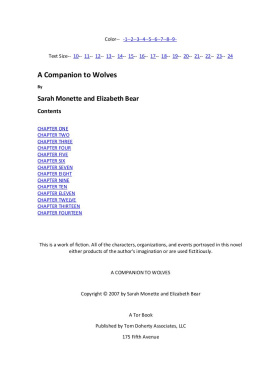Ian McAllister - The sea wolves : living wild in the Great Bear Rainforest
Here you can read online Ian McAllister - The sea wolves : living wild in the Great Bear Rainforest full text of the book (entire story) in english for free. Download pdf and epub, get meaning, cover and reviews about this ebook. year: 2013, genre: Detective and thriller. Description of the work, (preface) as well as reviews are available. Best literature library LitArk.com created for fans of good reading and offers a wide selection of genres:
Romance novel
Science fiction
Adventure
Detective
Science
History
Home and family
Prose
Art
Politics
Computer
Non-fiction
Religion
Business
Children
Humor
Choose a favorite category and find really read worthwhile books. Enjoy immersion in the world of imagination, feel the emotions of the characters or learn something new for yourself, make an fascinating discovery.
- Book:The sea wolves : living wild in the Great Bear Rainforest
- Author:
- Genre:
- Year:2013
- Rating:4 / 5
- Favourites:Add to favourites
- Your mark:
- 80
- 1
- 2
- 3
- 4
- 5
The sea wolves : living wild in the Great Bear Rainforest: summary, description and annotation
We offer to read an annotation, description, summary or preface (depends on what the author of the book "The sea wolves : living wild in the Great Bear Rainforest" wrote himself). If you haven't found the necessary information about the book — write in the comments, we will try to find it.
The sea wolves : living wild in the Great Bear Rainforest — read online for free the complete book (whole text) full work
Below is the text of the book, divided by pages. System saving the place of the last page read, allows you to conveniently read the book "The sea wolves : living wild in the Great Bear Rainforest" online for free, without having to search again every time where you left off. Put a bookmark, and you can go to the page where you finished reading at any time.
Font size:
Interval:
Bookmark:
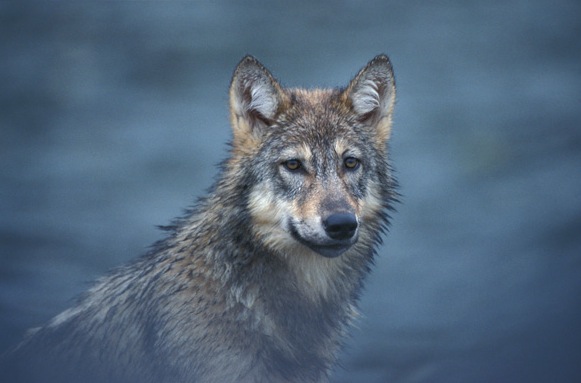
Wolves, like this young subadult, are curious, intelligent and among the most social animals on the planet.
A Bad Rap
Whos afraid of the big bad wolf, the big bad wolf, the big bad wolf? Whos afraid of the big bad wolf? Tra la la la la. You may remember this song from when you were younger. The Three Little Pigs sang it in a Disney cartoon made way back in 1933. (You can still see it on YouTube.) In the cartoon, the wolf, who walks upright on his hind legs and wears an Abe Lincoln stovepipe hat and hillbilly britches, blows down one little pigs house made of straw and another made of sticks. But he cant blow down the third pigs house because its made of bricks. So he scrambles up to the roof and climbs down the chimney only to be boiled alive in a cauldron of water in the fireplace. In the cartoon, the wolf manages to escapehis badly burned backside blowing a plume of smoke as he runs away. But in the original English version of the story, written more than half a century earlier, he isnt so lucky. The pig who built the brick house covers the pot and cooks the wolf for supper.
WOLF BITES
How are wolves and people alike?
Both are very social and very affectionate with their young. Both live in hierarchical societies (meaning someones the boss) and family groups. Wolves have alpha leaders who are like the parents of the pack. Both wolves and people are also very chatty. People love to talk, and so do wolves. They will bark, yelp, whine, whimper, growl, howl and squeak in different ways and at different volumes to let other wolves know whats on their minds. Also like humans, wolves are very territorial and willing to defend those territories to the death. Think of how many wars humans have fought over precisely the same thing.
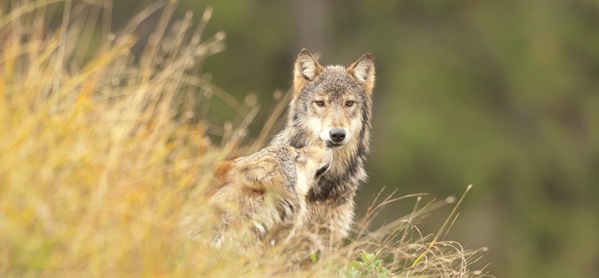
Two siblings share an affectionate moment in some tall grass. One of these young wolves may become the leader of his pack one day, but that will depend on leadership skills and whether he wants the job.
Regardless of which version of The Three Little Pigs you encounter, the message of the story is clear: wolves are big, bad and dangerousto people and pigsand the only good one is a dead one. Its a view many people have held for centuries. Think of the folktales you know in which wolves play a part. Then think about the parts those wolves play.
In Little Red Riding Hood, a German fairy tale also filmed by Disney, a wolf eats a little girls grandmother and then the girl herself. Theyre saved, however, when a hunter cuts the wolf open and finds the little girl and her grandmother alive and whole inside. The wolf also plays the villain in Peter and the Wolf, a Russian story in which a young boys pet duck is caught and eaten bywhat else?a wolf. Then, just as in Little Red Riding Hood, hunters capture the wolf, tie him up and take him to a zoo in a victory parade led by the boy, Peter. At the end, the storyteller says if you listen carefully you can still hear the duck quacking because the wolf, in his greed and haste for a meal, swallowed her alive.
But our fear and loathing of wolves doesnt end there. It shows up in sayings too. When we run short of money, we say the wolf is at the door, as if having a wolf at our door would be the very worst thing that could happen to us. When someone is described as being a wolf in sheeps clothing, it means he or she is really no good and is only pretending to be gentle and kind. When we cry wolf, it means were lying about, or exaggerating, a situation and will be punished for it.
With so many messages around about wolves being sly, unpredictable, vicious and bloodthirsty, is it any wonder that, even in a modern, scientific and environmentally aware society such as ours, people still regard them as enemies? Or worse, as verminsomething to get rid of?
WOLF BITES
Wolves in history.
The city of Rome is said to have been founded by Romulus and Remus, both sons of Mars, the Roman god of war, who were suckled as babies by a she-wolf. Because of this, Romans believed it was lucky to see a wolf. Julius Caesars victory over the Gauls in 195 BC was attributed to a wolf sent by Mars to frighten the enemy. Some ancient Europeans believed that when wolves howled, it was really the spirits of the dead calling to the living. The werewolf, which is half man and half wolf, was a monster made popular by Hollywood in the 1930s, but the idea probably came from the medieval practice of people dressing up as wolves. On BCs central coast, the Heiltsuk First Nation believes people belonging to the wolf clan are elevated in stature in times of war or famine, and that wolves are protectors and providers of their nation. The Cree, a First Nations people who live in large parts of eastern Canada and the US, tell a story somewhat like that of Noahs Ark. They believe that after the Great Flood, a wolf pushed a ball of absorbent moss round and round the survivors raft until the Earth was reformed.
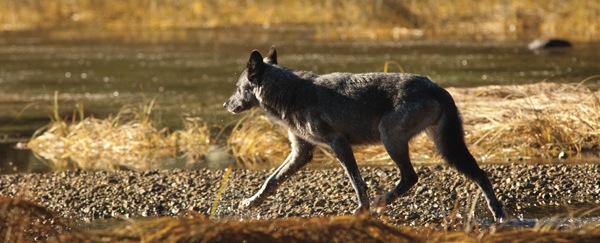
A black wolf searches for salmon on a bright fall day. Rainforest wolves come in different colorsranging from black to whitebut the most common color is brown with reddish highlights.
If you doubt that, consider that it wasnt long ago that wolves could be found throughout most of North America. Not anymore. Outside of Alaska they have been ruthlessly exterminated from 95 percent of the places they used to live in the United States. The US government hated them so much that for over a hundred years it paid a bounty, a reward of money, to whoever killed a wolf anywhere in the country. The same thing happened in Canada. One of the first acts of the new government of Upper Canadawhat is now Ontariowas to offer a cash payment to anyone who would rid the country of its wolves. Yet to this day there has not been a single documented case of a person in North America being killed by a wolf. (In 2005, a university student working in a mining camp in northern Saskatchewan was found dead with wolves observed nearby, but it has never been determined whether he was killed by wolves or a bear.)
Thankfully, wolves are still present in parts of North America. In Canada, which has far fewer people than the United States and therefore more room for wildlife, they can be found in most provinces except for parts of the Prairies and Maritimes. In British Columbia, where the wolves featured in this book live, theyre found almost everywhere except Haida Gwaii, a chain of islands off the provinces northwest coast. But even today they are under constant threat. In BC there are no real restrictions against killing them. You need a special license to hunt deer, ducks, geese, bear, moose and elk in BC. And when you kill a bear or an elk, you have to report when and where you made the kill. Not so with wolves. Officially youre allowed to kill three a year, but if you do, you dont have to tell anyone about it, which makes it almost impossible for anyone, including scientists, to understand the full impact hunting has on wolves.

These two wolves belong to a pack conservationists have called the Fish Trap pack because it lives near an ancient First Nations fishing spot. They feed on salmon between September and November.
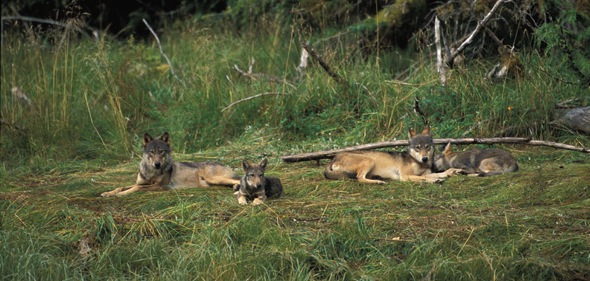
Font size:
Interval:
Bookmark:
Similar books «The sea wolves : living wild in the Great Bear Rainforest»
Look at similar books to The sea wolves : living wild in the Great Bear Rainforest. We have selected literature similar in name and meaning in the hope of providing readers with more options to find new, interesting, not yet read works.
Discussion, reviews of the book The sea wolves : living wild in the Great Bear Rainforest and just readers' own opinions. Leave your comments, write what you think about the work, its meaning or the main characters. Specify what exactly you liked and what you didn't like, and why you think so.

